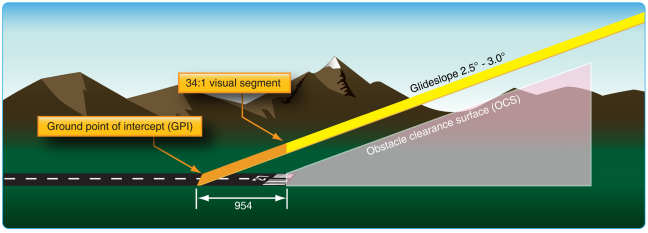Regulations for
Module f14
The airport has a working Instrument Landing System
(ILS) working for runway 24L, and the corresponding ILS receiver
equipment on the aircraft is working fine. You and the captain
have
appropriate training and extensive experience using these systems.
The ILS system, when tied into the aircraft autopilot,
guides the airplane toward the airport, even if the weather is so bad
that the pilots cannot see where they are going. This guidance
not only brings them to the proper location at the end of the runway (the "localizer" portion of the system),
but it also guides their gentle descent along the "glideslope" so that
they arrive over the threshold (arrival end of the runway) at the right
altitude.
The first picture below is a top-down view, showing the "localizer"
radio signals to the left and right of the runway centerline (the
airport is at the left edge of this figure). The second picture
shows the "glideslope" radio signal. These two signals guide the
aircraft to the approach end of the runway when the aircraft is flying
in instrument conditions (i.e., when the pilot can't see where she/he
is going). The ILS is a very old system - - modern systems make
heavy use of GPS.


Nonetheless, when the aircraft gets close to the threshold
at an altitude called the Decision Height (DH), the pilot in command
must be able to see the runway or surrounding landmarks in order to
continue to land on the runway. If the pilot cannot see the
runway, or if the runway is unsafe to land on, then the pilot executes
a "missed approach". Namely, the pilot aborts the landing by
adding power to the engines and pointing the nose of the aircraft up at
an appropriate angle to safely climb away from the ground. The
pilot flys to a designated "missed approach point" (altitude and
location), from where they can ask the air traffic controllers for a
clearance to try again, or to divert to an alternate airport.
The Decision Height is 250 feet above the ground, for this
aircraft at Toronto runway 24L.
Image credits.
Glideslope: FAA Instrument Procedures Handbook (2015). https://www.faa.gov/regulations_policies/handbooks_manuals/aviation/instrument_procedures_handbook/media/Chapter_4.pdf
Localizer: FAA Instrument Flying Handbook (2012). https://www.faa.gov/regulations_policies/handbooks_manuals/aviation/media/FAA-H-8083-15B.pdf

